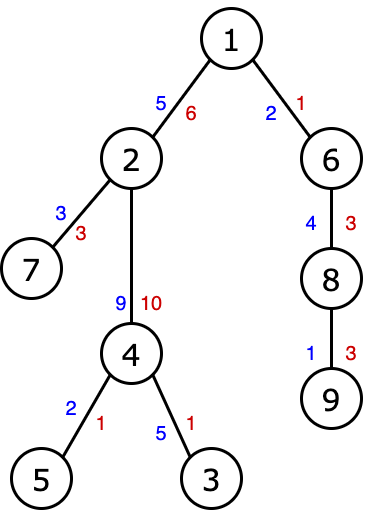CF1714G.Path Prefixes
普及/提高-
通过率:0%
AC君温馨提醒
该题目为【codeforces】题库的题目,您提交的代码将被提交至codeforces进行远程评测,并由ACGO抓取测评结果后进行展示。由于远程测评的测评机由其他平台提供,我们无法保证该服务的稳定性,若提交后无反应,请等待一段时间后再进行重试。
题目描述
You are given a rooted tree. It contains n vertices, which are numbered from 1 to n . The root is the vertex 1 .
Each edge has two positive integer values. Thus, two positive integers aj and bj are given for each edge.
Output n−1 numbers r2,r3,…,rn , where ri is defined as follows.
Consider the path from the root (vertex 1 ) to i ( 2≤i≤n ). Let the sum of the costs of aj along this path be Ai . Then ri is equal to the length of the maximum prefix of this path such that the sum of bj along this prefix does not exceed Ai .
 Example for n=9 . The blue color shows the costs of aj , and the red color shows the costs of bj .Consider an example. In this case:
Example for n=9 . The blue color shows the costs of aj , and the red color shows the costs of bj .Consider an example. In this case:
- r2=0 , since the path to 2 has an amount of aj equal to 5 , only the prefix of this path of length 0 has a smaller or equal amount of bj ;
- r3=3 , since the path to 3 has an amount of aj equal to 5+9+5=19 , the prefix of length 3 of this path has a sum of bj equal to 6+10+1=17 ( the number is 17≤19 );
- r4=1 , since the path to 4 has an amount of aj equal to 5+9=14 , the prefix of length 1 of this path has an amount of bj equal to 6 (this is the longest suitable prefix, since the prefix of length 2 already has an amount of bj equal to 6+10=16 , which is more than 14 );
- r5=2 , since the path to 5 has an amount of aj equal to 5+9+2=16 , the prefix of length 2 of this path has a sum of bj equal to 6+10=16 (this is the longest suitable prefix, since the prefix of length 3 already has an amount of bj equal to 6+10+1=17 , what is more than 16 );
- r6=1 , since the path up to 6 has an amount of aj equal to 2 , the prefix of length 1 of this path has an amount of bj equal to 1 ;
- r7=1 , since the path to 7 has an amount of aj equal to 5+3=8 , the prefix of length 1 of this path has an amount of bj equal to 6 (this is the longest suitable prefix, since the prefix of length 2 already has an amount of bj equal to 6+3=9 , which is more than 8 );
- r8=2 , since the path up to 8 has an amount of aj equal to 2+4=6 , the prefix of length 2 of this path has an amount of bj equal to 1+3=4 ;
- r9=3 , since the path to 9 has an amount of aj equal to 2+4+1=7 , the prefix of length 3 of this path has a sum of bj equal to 1+3+3=7 .
输入格式
The first line contains an integer t ( 1≤t≤104 ) — the number of test cases in the test.
The descriptions of test cases follow.
Each description begins with a line that contains an integer n ( 2≤n≤2⋅105 ) — the number of vertices in the tree.
This is followed by n−1 string, each of which contains three numbers pj,aj,bj ( 1≤pj≤n ; 1≤aj,bj≤109 ) — the ancestor of the vertex j , the first and second values an edge that leads from pj to j . The value of j runs through all values from 2 to n inclusive. It is guaranteed that each set of input data has a correct hanged tree with a root at the vertex 1 .
It is guaranteed that the sum of n over all input test cases does not exceed 2⋅105 .
输出格式
For each test case, output n−1 integer in one line: r2,r3,…,rn .
输入输出样例
输入#1
4 9 1 5 6 4 5 1 2 9 10 4 2 1 1 2 1 2 3 3 6 4 3 8 1 3 4 1 1 100 2 1 1 3 101 1 4 1 100 1 2 1 1 3 1 101 10 1 1 4 2 3 5 2 5 1 3 4 3 3 1 5 5 3 5 5 2 1 1 3 2 6 2 1
输出#1
0 3 1 2 1 1 2 3 0 0 3 1 2 2 0 1 2 1 1 2 2 1 1
说明/提示
The first example is clarified in the statement.
In the second example:
- r2=0 , since the path to 2 has an amount of aj equal to 1 , only the prefix of this path of length 0 has a smaller or equal amount of bj ;
- r3=0 , since the path to 3 has an amount of aj equal to 1+1=2 , the prefix of length 1 of this path has an amount of bj equal to 100 ( 100>2 );
- r4=3 , since the path to 4 has an amount of aj equal to 1+1+101=103 , the prefix of length 3 of this path has an amount of bj equal to 102 , .